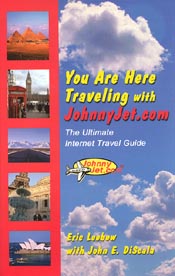 |
The Book of the Website - Johnny Jet | |||||
|
Why would someone buy a book full of links to internet websites? More to the point, why would someone buy a book that essentially duplicates information already on a website? Plainly many people have an answer to this question, because 'Johnny Jet's book quickly sold out of its first print run and is now in a second printing.
The book contains more helpful information than that on Johnny Jet's website, albeit for fewer sites, and also presents information in different ways. But does it make sense to buy a book full of weblinks that rapidly becomes out of date when there is an electronic equivalent available for free?
[serverinclude/googleads/GA-160600-rhs-belowtop.htm]
|
John DiScala is better known as internet travel link maven Johnny Jet. Over the last four years he has invested many thousands of hours tracking down and categorizing over 5000 different links to a huge range of different travel related websites. The fruits of his labors can be seen at the universally praised www.JohnnyJet.com. His achievement is proof that there still remain opportunities for individuals to create major web niches for themselves. Johnny also offers a free weekly newsletter, with interesting personal travel experiences to recount every week, as well as featured websites and other interesting travel related news. His website is one of the very best collections of indexed travel links available, and an invaluable tool to help find the information a would-be traveler might be seeking. But what about the book? How does the $14.95 book add value to the wealth of information available on his website for free? What the Book Contains The soft covered book, co-authored with Internet guru Eric Leebow who has written other Internet guides, measures just over 5½" x 8½" and is an impressive 1.4" thick, with 557 pages of information inside. There are 34 major headings (chapters) and within these chapters, a comprehensive 295 categories. In addition, there are eight quick reference guides (Destination information by State and Country, Auto rentals, Hotel/motels, US airlines, airfreight companies, Travelers Checks and Credit cards), a listing of 'Johnny Jet Codes' and AOL keywords, an index and a contents. Each of the chapters starts with a page or so of introductory comments that range that are sometimes interesting and helpful. The 34 chapters don't match to the 39 major categories listed on the website home page, although perhaps there is little need to do a one for one match between the website and the book. Special Feature - Johnny Jet Codes Rather puzzlingly, perhaps as many as one third of the categories don't actually have any printed website links. It is hard to understand why the categories for, eg, Amazing Cathedrals or Packing have no links listed, but the category for Linen Care does. What is the point of creating a category if there are no links included? Because, although there might be no links in the book, there are still links on that topic on the website. In all cases, each category has a Jet Code which you can type in to the website and that will then reveal a series of website links. I can't actually find anywhere in the book which tells where to go on the website to type in the code, but there is a moderately prominent link near the top of the website's home page that people can click on. The Website Links Within most of the categories, there is anything from 0 to perhaps 100 or more links to different web sites. In many cases, the webpage link is accompanied by a short description of the website as well, which can help you better decide if the website might be relevant to what you are looking for. This is the key bonus feature that doesn't exist on the website, where the links do not have descriptions. On the website, there are an estimated 5000 links to travel websites. In the book, there are an estimated 3000 links to websites. The book does not include all the websites that are on the website, and the selection for what is and is not included is quirky and hard to follow. Choosing a category at random - for example, the section on Women Travelers, shows that there are 19 websites listed in the book. On the website, there are half as many again - 27. By comparison, Yahoo's Women's Travel Directory (which is listed in the book but not on the website), there are 68 links. Google lists over a million sites. It is surprising, therefore, that one of these 19 'crème de la crème' links is given to something as narrowly specialized as a travel diary written by a woman hitchhiking through Vietnam. And what is even more puzzling is that this link, featured in the book, doesn't appear at all on the website! Although the book has a large number of links, this represents only a very narrow slice of the total number of travel websites out there. The book has 3000 website links, whereas Yahoo's travel directory has links to 150,000 or more websites. In some cases the book has links to nearly every possible website on a subject (for example, airlines or rental car companies) but in other cases, the book has only a small percentage of all websites listed, and with a total of 'only' 295 categories, there are still some travel topics for which the book has no information at all. Like most other travel website owners, I eagerly went looking for my own website listing. The site is well featured on Johnny Jet's website, but, no matter what category I searched under, it is completely missing from his book! Problems Using the Book I discovered an unexpected but inconvenient problem with the concept of a printed listing of websites when I started visiting some of the featured links. Of course, you have to type the entire url into your browser. I had become so used to either cutting and pasting, or simply clicking, that I'd almost forgotten about the need to type in long complicated urls by hand. I then tried going to the Jet Code page and clicking on the link from that page, but I found it very difficult to recognize which of the links on the code page represented which of the websites listed in the book. And, as mentioned above, not all the links in the book appear on the website, and neither do all the website links appear in the book. And then I went to a link from the book only to find that it did not exist any more. Another potential but less obvious challenge is that a new good website may be created, but it will not be listed in the book. The book quickly starts to become out of date, as soon as it is printed. If you are not an internet user, then of course the book is largely useless to you. It has almost no content of its own, just lots of links to websites. And, if you are an internet user - do you really need the book when Johnny Jet's excellent website presents more information (and more up to date information), and when there are also other travel related indexes such as Yahoo, and other search engines (such as Google)? The Web's Evolution and Google as an Alternative When the world wide web was in its early stages, there were only a few thousand websites. You could visit them all. Magazines published 'maps' of the internet showing how the websites were linked to each other. As the web evolved, the number of websites became too large for any one person to comprehend. And so books such as the 'Internet Yellow Pages' appeared - as its name suggests, it was an index of most of the websites on the internet, and for several years, was a very popular (and even essential) book. As the web evolved some more, Yahoo appeared with its manually indexed listing of websites by theme and topic. The web was by now evolving too quickly for an annual yellow pages type publication, and was too big to be listed in any one book. Yahoo was very helpful. As the web grew even larger, the percentage that Yahoo indexed became smaller and smaller. To fill in the missing coverage, automated 'web crawlers' and 'web spiders' appeared, searching through the web, indexing the sites they found, and providing search tools for web users. These search tools were not very friendly or easy to use, but were a lot better than nothing. And then, in the late 1990s, Google burst onto the scene. Using completely new ways to evaluate and index web pages, and with a massive database of websites, all of which it indexed for free, it quickly redefined the web searching marketplace. Today over 75% of all web searching is done through Google, and Google indexes over 3 billion web pages every month or two. Google's enormous power is both its greatest strength and also its greatest weakness. Although Google has an uncanny ability to present brilliant websites that exactly match what you were looking for, you can still spend a lot of time searching through its huge number of results that are only what a computer thinks might be relevant, not what a real person has actually evaluated and individually decided to include or not. That is where a manually indexed list of links can be invaluable. The reality is that neither method is totally perfect. A manually indexed list is necessarily going to be incomplete, and also inconsistent in what is included and not included (for example, some travel themed indexes don't include my website purely because the indexer doesn't agree with my opinions). And so, if you're trying to find something unusual or very specific, and if it is essential to do a very comprehensive review of all websites, your best bet is probably a mix of using specialty manually compiled web indexes and Google too. Summary Johnny Jet's website is more useful than his book. The book's descriptions are helpful, but it would no slower to click on links from his website than to read through descriptions, choose a site, then type the link in to the computer. The book might make a good gift, and if you're a Johnny Jet fan, you might choose to buy the book as a gesture of support. It is believed that he may soon be selling autographed copies from his website. But for everyone else, I think that Johnny Jet has reduced the value of the book by making his website so good to start with! Truly - who needs the book when you have his excellent website, with more links, and more uptodate, than the book. However, if you would like a copy, and it has been generally well reviewed by most others, please click here to buy a copy. I'll get a 5% commission! Related Articles, etc
Tell David your opinion. Send him an Email - [email protected]
Originally
written 6 June 2003, last update
21 Jul 2020 |
|||||
